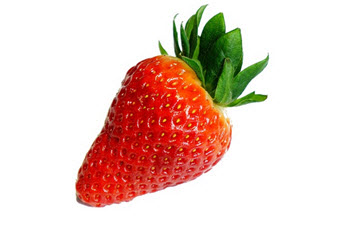Contents

The popular garden strawberry (Fragaria × ananassa) is an excellent source of several vitamins, especially vitamin C and vitamin K. Examples of other nutrients that are present in fairly large amounts in strawberries are folic acid, manganese and potassium. Strawberries are also a good source of fiber. Eating 100 grams of strawberries will provide you with roughly 2 grams of fiber, slightly above 30 calories and less than 0.5 grams of fat.
In the United Kingdom, the season for fresh domestically grown strawberries runs from late May through July. Fresh and frozen imported strawberries are available year round.
Anthocyanidins
The characteristic red color of the strawberry is caused by anthocyanidins. Anthocyanidins are chiefly known for their antioxidant properties, and are currently being researched for their proposed ability to protect against inflammation, cancer and certain types of heart disease.
Since anthocyanidins are antioxidants they inhibit the oxidation of other molecules. When molecules oxidate in the human body the process can produce free radicals, and this can set off a chain reaction that ultimately damages cells.
Examples of foods that are rich in anthocyanidins are strawberries, raspberries, blackberries, blueberries, red and black grapes, cranberries, red cabbage and red onions. What they all have in common is that they exhibit strong red or purple colors. Cooking can have a negative impact on the amount of available anthocyanidins, so it’s a good idea to chose foods that you are happy to eat raw, such as a generous serving of fresh or frozen strawberries.
The stability of anthocyanidins is dependent on the pH-value. In acidic conditions, colored anthocyanidins are present. When conditions are basic, colorless chalcones forms are present instead.

Buying, handling and eating strawberries
- When buying strawberries, ideally seek out the ones that are firm and plump and display a good coloration. Stay clear of blemished, moldy, rotten or otherwise damaged strawberries.
- When strawberries are sold in boxes, it is a good idea to check all of them as soon as you get home and remove any bad berries to prevent any problems from spreading to the good berries.
- Once a strawberry has been picked from the plant, it will not ripen any further. If you buy a green or yellow strawberry, it will remain un-ripe until it goes bad and rots away.
- Handle strawberries with care, they bruise easily.
- If you have stored your strawberries in the fridge, take them out and allow them time to reach room temperature before you serve them, since this helps bring out the flavors.
- Wash strawberries right before serving them or using them as an ingredient.
- Frozen strawberries are a good alternative in certain situations, e.g. for making smoothies or using in pies. Fully thawed strawberries can be rather listless and mushy.
- If you are allergic to birch pollen, there is in increased risk of you being allergic to strawberries as well.
- The white strawberry contains less of the allergen responsible for triggering an allergic reaction, but it is not completely free from the allergen. Eating white strawberries is therefore not considered safe for a person with a strawberry allergy.
Strawberry leaves
Strawberry leaves are eaten raw and used to make herbal infusions.
In Europe, there is a long history of using the entire wild strawberry plant, including the leaves, in an effort to treat depression.
About strawberries
| Scientific classification | |
| Kingdom: | Plantae |
| (unranked): | Angiosperms |
| (unranked): | Eudicots |
| (unranked): | Rosids |
| Order: | Rosales |
| Family: | Rosaceae |
| Subfamily: | Rosoideae |
| Genus: | Fragaria |
| Species: | Fragaria × ananassa |
| Binomial name | |
| Fragaria × ananassa | |
From a botanical standpoint, the strawberry isn’t a berry. It is an aggregate accessory fruit.
The garden strawberry (Fragaria × ananassa) is a hybrid within the genus Fragaria. Within this genus, we find many different species of strawberry, such as the Woodland strawberry (Fragaria vesca) that grows wild throughout much of the northern hemisphere and the Fragaria yezoensis which is native to Japan and nearby parts of easternmost Russia.
 The garden strawberry was created in Brittany, France in the 1750s when Fragraria virginiana was crossed with Fragaria chiloensis. Fragraria virginiana is native to eastern North America, while Fragaria chiloensis grows wild along the Pacific Ocean coasts of both North and South America. This hybrid eventually replaced the Fragaria vesca in commercial production of strawberries.
The garden strawberry was created in Brittany, France in the 1750s when Fragraria virginiana was crossed with Fragaria chiloensis. Fragraria virginiana is native to eastern North America, while Fragaria chiloensis grows wild along the Pacific Ocean coasts of both North and South America. This hybrid eventually replaced the Fragaria vesca in commercial production of strawberries.
Today, many different cultivars of the garden strawberry Fragaria × ananassa is available and we can enjoy strawberries of various shapes, sizes, coloration and taste profiles. The cultivars also vary from each other when it comes to factors such as season of ripening, preferred growing conditions and resilience towards certain pathogens.
Europe before the garden strawberry
F. vesca had been cultivated in Europe since the early 1600s, but was picked in the wild and sold long before that. There are several mentioning of the alleged medical properties of wild strawberries in ancient Roman medical literature. In France, wild strawberry plants have been moved from the wild to gardens since at least the 14th century. Charles V who ruled the country in the mid 1300s had well over a thousand strawberry plants in his royal garden!
